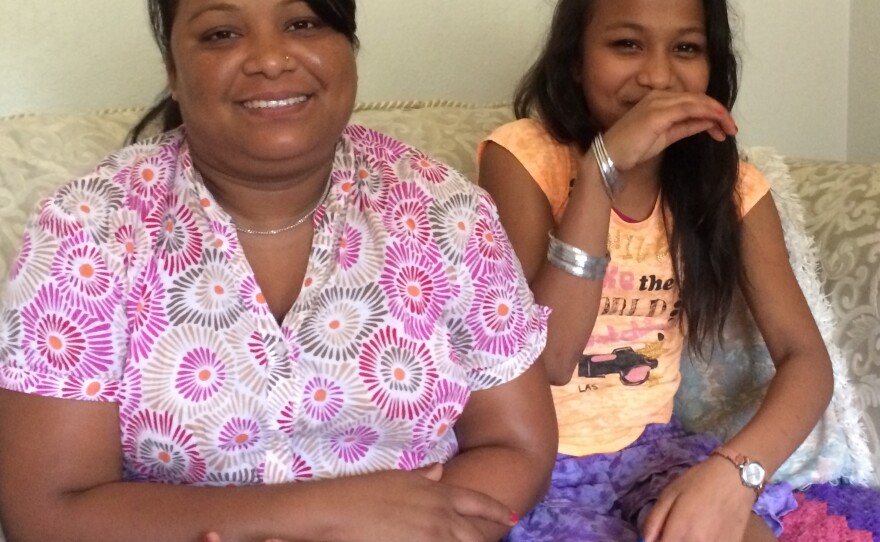It’s always a struggle to resettle in a new country, but for Bhutanese refugees, the challenge has been especially difficult. Bhutan, a largely Buddhist country, is known for having created a ‘national happiness index,’ but it has also forced out many of its ethnically Nepali, mostly Hindu, population. Since arriving in the United States, many of these refugees have suffered serious mental health issues.
Making the rounds at a public housing complex in Kansas City, Kansas, community health worker Rinzin Wangmo is greeted by cheery voices and faces. As she enters a home, the heavy aroma of chopped onions burns her nose, and she hurries up a short flight of stairs to escape the sting. After gently knocking on a door, she walks in to meet with a woman who’s bedridden with pain. The woman’s condition is not unusual among Bhutanese refugees, says Dr. Joe LeMaster, a University of Kansas professor who worked for a decade in the Himalayas. “They went through quite a lot,” he says, “and that has had its mark on them.”
For hundreds of years, Nepali people lived and worked in southern Bhutan. But in the early 1990s, a government campaign of harassment and what Human Rights Watch described as ‘ethnic cleansing’ led tens of thousands of Nepalis to flee to refugee camps in Nepal. In 2006, the United States offered to resettle some of the refugees, and since then over 75,000 have arrived in cities like Philadelphia, Denver and Kansas City.
Jenga Chhetri was twenty-three when he convinced his family to resettle in the U.S. nearly three years ago. But not long after they arrived, his parents told him moving here was a mistake.
“At the time, my parents, they blamed me,” says Chhetri.
Many Bhutanese refugees have had trouble adapting to life in the U.S. As the organizer of a Bhutanese health outreach program, Dr. LeMaster says he’s seen lots of suffering among his patients. “Within a month of getting here, somebody committed suicide, and we began to be become aware that the risk of suicide in the Bhutanese refugees is about three times the risk in other refugee groups,” he says.
A report released earlier this year by the Centers for Disease Control and Prevention highlights the acute problems of suicide, anxiety and depression among Bhutanese refugees throughout the U.S, though the causes are still unclear. The CDC says the problems may be related to social isolation, substance abuse, or trauma from torture they endured in Bhutan.
LeMaster and his team tried to address the refugees’ mental health problems, but they found that the cultural stigma associated with the very idea of mental illness made the work nearly impossible. “They were then telling us what we feel is not stress so much; we feel pain,” he says.
Testing showed no underlying medical reasons for their chronic pain, and standard treatments, including physical therapy, pain killers and psychiatric drugs didn’t help. Despite what the refugees told him, LeMaster believed the pain was related to stress, and he decided to explore what alternative treatment methods interested the refugees.
The team tried art therapy, dance therapy, and tai chi. Some of the refugees, originally from rural areas, said they missed being around cows, so LeMaster’s team tried taking them on trips to a petting zoo, with some success. They finally landed on a treatment that showed the greatest promise: yoga.
Yoga therapist Claudia Cardin-Kleffner specializes in working with people who have chronic health conditions, but she’d never seen a class like the one Dr. LeMaster brought to her -- one made up of middle-aged to older Bhutanese women refugees. “I could not even begin to understand what was going on with these people because they couldn’t breathe,” Cardin-Kleffner recalls. The women were stiff and withdrawn. Many wouldn’t make eye contact.
Yoga has a long history in the Himalayas, and in Nepal in particular. Though most of the refugees were Hindus who had some understanding of yoga, they had little actual experience with it.
“Just getting them to move their arms was really difficult,” Cardin-Kleffner recalls. The women at first didn’t understand why they should do the movements, and learning how to do them was also difficult.
Among the class members was Jenga Chhetri’s mother, Ratna. Jenga translates for her: “I had back pain and leg pain. But right now, that’s not happening in my body.”
Dr. LeMaster says that earlier in his career, he would have been hesitant to prescribe yoga, and he was surprised by the program’s success. The women’s levels of pain on a standard pain index dropped dramatically. Beyond that, the participants showed major improvements on standard measures of anxiety, depression and acculturation.
Recent studies have shown how yoga helps the brain, heart and nervous system. But why did it work when physical therapy and medications did not?
That’s something LeMaster’s still trying to understand, but the answer may have to do with cultural familiarity. “What we did notice is that the concepts resonated with what their basic resonated Hindu worldview was. So there was nothing in it that jarred them,” he says.
There hasn’t been a suicide among the Kansas City refugees since LeMaster instituted the program. And while LeMaste can’t say for certain that yoga has saved lives, he thinks it could be used to help struggling Bhutanese in other cities.
Now he’s studying how yoga and other culturally-based practices could be used to help additional immigrant groups.
Alex Smith is a reporter for Heartland Health Monitor, a reporting collaboration on health issues based at KCUR in Kansas City, Mo.









